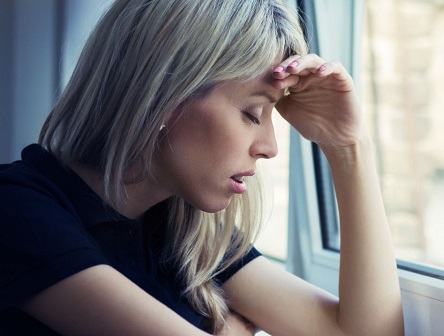Estrogen is a sex hormone that is the primary hormone responsible for female sexual characteristics. These characteristics in women include larger breasts, wider hips and more body fat than is typically seen in men. Estrogen is also the hormone that results in less hair and smoother skin in women. Although men also have some estrogen, this hormone is much higher in women. When a woman's estrogen drops, a condition called low estrogen develops.
Symptoms of Low Estrogen
Signs and symptoms of low estrogen can vary from woman to woman and may depend on how low the estrogen level goes.
Some of the signs and symptoms that you may be suffering from low estrogen include sleep disturbances that can lead to extreme daytime fatigue, inability to focus on tasks, and a sense that you just "don't feel right". These sleep disturbances may result from a combination of heart palpitations, hot flashes, night sweats, and cold chills. You may notice that you are gaining weight -- particularly water weight -- while your eyes, skin and vagina are becoming dryer. You may begin to develop joint pain and headaches. You may be more prone to broken bones as the calcium is pulled out of your bones and your bones become more brittle. Your sex drive may lower as your estrogen level drops. You may begin to develop more vaginal and bladder infections. Any combination of these signs and symptoms of low estrogen can lead to severe depression.
Causes of Low Estrogen
The causes of low estrogen can be as variable as the signs and symptoms. In older women who are approaching menopause, decreasing estrogen levels are common and ultimately result in the cessation of menses. In younger women, low estrogen can result from several physical or behavioral problems including:
- Decreased functioning of the ovaries;
- Cysts on and in the ovaries;
- Pregnancy problems that lead to miscarriage;
- Childbirth and breast-feeding;
- Decreased functioning of the pituitary gland;
- Eating disorders and dieting resulting in low body fat;
- Certain fertility drugs;
- Excessive exercise resulting in low body fat.
Treatments for Low Estrogen
If you suspect you have this condition, the first thing to do is see your healthcare provider. A simple blood test can determine if a low estrogen level is causing your symptoms -- or if something else may be the cause. Low estrogen is usually defined as a level below 100pg/ml (picograms per milliliter). There are both medical treatments and home remedies that you can try if you are diagnosed with low estrogen.
Medical Treatments
After being diagnosed with low estrogen, your healthcare provider will begin searching for the cause of the problem. For an older woman, the issue may not be a problem at all, but may simply be a result of the normal aging process. In a younger woman, your doctor will run additional tests to identify the root cause of the problem. After the underlying cause is identified, that will become the focus of treatment.
When other causes are ruled out, your healthcare provider may prescribe hormone replacement therapy (HRT). Although HRT may be effective, this treatment is controversial and is sometimes used for short periods as the underlying cause is treated. The use of HRT may increase the risk for developing heart problems, stroke or cancer.
Home Remedies
Fortunately, there are some things you can try at home to manage low estrogen symptoms.
- Keep a Healthy Diet. First, make a few changes to your diet. Lower your intake of
 carbohydrates and fats and increase the fiber in your diet. There are certain foods that are high in naturally occurring estrogens called phytoestrogens. These foods include soybeans, tofu, edamame and other beans, peas, fruits, vegetables and bran. Be sure to include foods high in vitamin C, the B vitamins, and carotene. Some of these foods include oranges and other citrus fruits, artichokes, asparagus, corn, peppers, kale, spinach, carrots, beets, bananas, avocadoes, collard greens and chard, and many seeds and nuts. Fresh foods are better than processed foods and eating a well-balanced diet will help your body produce its own estrogen.
carbohydrates and fats and increase the fiber in your diet. There are certain foods that are high in naturally occurring estrogens called phytoestrogens. These foods include soybeans, tofu, edamame and other beans, peas, fruits, vegetables and bran. Be sure to include foods high in vitamin C, the B vitamins, and carotene. Some of these foods include oranges and other citrus fruits, artichokes, asparagus, corn, peppers, kale, spinach, carrots, beets, bananas, avocadoes, collard greens and chard, and many seeds and nuts. Fresh foods are better than processed foods and eating a well-balanced diet will help your body produce its own estrogen. - Add Herbs. There are certain herbs that may help by providing nutrition to the glands that produce estrogen. An herb that may be particularly useful is chasteberry. Found in many health food stores and pharmacies, chasteberry is an herb that may be useful for increasing the normal production of estrogen. Before taking any herb, be sure to consult your healthcare provider particularly if you are taking psychiatric drugs, any medications for Parkinsonism, or birth control pills. The active ingredients in herbs may interact with other prescription and over-the-counter drugs.
- Monitor Your Exercise. Low body fat has been linked with low estrogen levels. Regular, moderate exercise (about 30 minutes each day) is a healthy habit to prevent obesity, diabetes, heart disease and other health problems. Moderate exercise may actually help increase low estrogen levels. However, excessive exercise may decrease estrogen levels causing many symptoms and health problems.
- Stop Using Tobacco. Using tobacco indirectly lowers estrogen levels by the effect it has on the endocrine system. Some research shows that the use of tobacco may be linked to infertility and early menopause.
- Use Caffeine. This one may come as a surprise! Studies show that women who drink at least two cups of coffee each day may actually increase their estrogen levels. If you are pregnant or breast-feeding, be sure to consult your healthcare provider before increasing your intake of caffeine.
